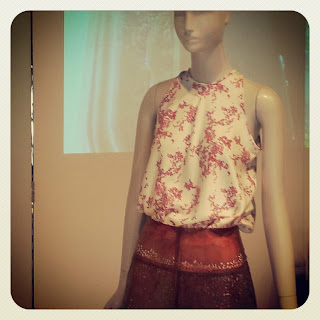On Sunday the 16th of Feb 2014 , Selfridges held a Biocouture workshop for Festival of Imagination, in collaboration with Super/Collider and Amy Congdon.
Suzanne
Lee opens the workshop with an introduction to microbial cellulose and
introduces us to the edible, sweet kombucha style dessert popular to many in
the far east of the world. This dessert originated from a coconut recipe in the
Philippines
Suzanne spoke about the well-known and loved kombucha health drink, and
offers everyone a taste.
We
were shown these simple food stuffs as kombucha drink and the dessert is the
result of the fermentation of a live kombucha culture, which is the production
method of growing the fabric for the above skirt!
“Kombucha
is a symbiotic colony of bacteria and yeasts (SCOBY).
The main bacteria, Gluconacetobacter xylinum, produces nanofibrils of cellulose which self-organise into a nano-structured, textile-like material.” ~ Biocouture
The main bacteria, Gluconacetobacter xylinum, produces nanofibrils of cellulose which self-organise into a nano-structured, textile-like material.” ~ Biocouture
Live
kombucha culture is a byproduct and foodstuffs made of kombu, or kelp, from the
seaweed family, Laminariaceae.
 |
| Microbial cellulose samples |
 |
| Susan Lee's Biocouture Jacket |
 |
| Microbial cellulose skirt |
The
fabric itself feels softer than you’d imagine at first glance. Eight sheets are
lined up before us – with smaller sheets that are textured with salt, or that
have been laser cut. We each get to have a feel – some
caress it, other sniff it, while Suzanne encourages someone to scrunch it up,
and then watch it go back to its original form, barely creased. So on first
glance and through that experiment, the first impression of the fabric is that
it’s durable and relatively hard wearing – it doesn’t scratch, tear or get
creased up easily. But Suzanne goes on to explain that, if it got damp enough,
it would turn back into its original state – it would absorb water and produce
more bacteria that it is made from.
If
leather got damp enough, it would do the same – it would become a little less
durable and more rubbery to touch. That being said, this fabric has been known
as a potential ‘leather alternative’.
The
commercial ability of this material derived from bacteria isn’t strong,
although, the purpose, as defined by Suzanne Lee and Amy Congdon, is to invite
audiences into new ways of seeing and understanding the potentiality of this
organic, and smart use of resources and to translate this into more ideas, and
to design with this theory in mind.




